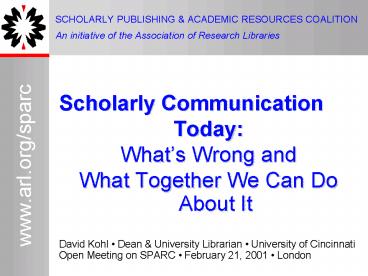Scholarly Communication - PowerPoint PPT Presentation
1 / 25
Title:
Scholarly Communication
Description:
What Together We Can Do About It. David Kohl Dean & University Librarian University of Cincinnati ... SCHOLARLY PUBLISHING & ACADEMIC RESOURCES COALITION ... – PowerPoint PPT presentation
Number of Views:222
Avg rating:3.0/5.0
Title: Scholarly Communication
1
SCHOLARLY PUBLISHING ACADEMIC RESOURCES
COALITION An initiative of the Association of
Research Libraries
- Scholarly Communication
- Today
- Whats Wrong and
- What Together We Can Do About It
- David Kohl Dean University Librarian
University of Cincinnati - Open Meeting on SPARC February 21, 2001 London
2
Scholarly Communication Crisis
- Faculty and students need greater access than
ever before to journal literature - Libraries almost universally are being forced to
reduce access to journals - Even monographic acquisitions have suffered
We are spending more money but getting fewer
books and journals
3
Immediate Cause
- For almost two decades, journal costs have far
outpaced inflation - Primarily commercial publishers
- Particularly STM journals
4
(No Transcript)
5
Scholarly Communication Impeded
Prices are high and rising...
Examples
For a list of 100 of the most expensive journals
(including 4-year price trend and editors), see
www.createchange.org/resources/journal.html
6
Underlying Causes
- Academy has lost control of scholarly publishing
- Academic publishing is now big business
- Commercial publishers dominate the market
- Focus of academic publishing has shifted from
scholarly communication to generating profits
7
Early Days of Happy Innocence
- For 300 years, scientific communications was a
community enterprise - Scientists organized themselves in societies to
- Share ideas with colleagues (e.g., conferences)
- Verify the quality
- of work (peer review)
- Disseminate new
- ideas (e.g., publishing)
8
Traditional Role of Libraries
- Organize knowledge
- Help scholars know what work has already been
done - Overcome inability of individuals to collect all
published works - Distribute information to a wide range of users
9
Traditional Knowledge Exchange
LEARNED SOCIETY
LIBRARY
AUTHOR
READER
10
The Roots of Dysfunction
- Beginning after World War II
- higher education enrollments grew
- expanded funding flowed into academe
- faculty size increased
- quantity of research increased
- demand for publication increased
- to disseminate research
- to obtain tenure promotion
- to compete for grants
11
The Fall
- Society publishers failed to meet demand
- insufficient publishing capacity
- unwillingness or inability to expand
- Commercial publishers entered market
- many existing journals outsourced by societies
journal size expanded - new journals started to accommodate growth
- - growing quantity of research
- - new increasingly specialized domains
(twigging)
12
Clash of Cultures
- Goal
- Strategy
- Reward
- Scholarship
- wide distribu-tion of work
- publish
- reputation, tenure, promotion
Commerce maximize share-holder value control
info access price increased financial return
13
Scientific Publishing Today
Source Outsell Inc.
14
Library Strategies
- Journal cancellations reduced monograph
acquisitions - Purchase by the drink rather than by
subscription - Cooperative collection development and consortial
purchase - Site licensing of electronic information
15
The Fundamental Problem Remains
- How to restore journal publishing to its primary
academic purpose - Reasonable pricing
- Focus on scholarly communication rather than
profits - Active exploration of the possibilities of new
technologies to enhance scholarly communication - Consciousness-raising within the academic
community
16
In Other Words
- Dont get better at the game,
- Change the Rules of the game!
17
How to Accomplish Fundamental Change
- The North American research library community
began to discuss this issue in the biannual ARL
meetings of the mid/late 90s - Out of a series of internal discussions a
consensus arose that we would use our buying
power to actively intervene in and change the
direction and nature of academic publishing
18
Four Things Were Necessary
- Core group of libraries representing a
significant market share who would act together - War Chest
- Action organization
- Staff
- (A sexy name for the organization is optional)
19
Core Group
- The obvious core group for North America were the
ARL libraries - Voluntary association (peer pressure)
- Provided foundation and visibility
- Founding group 81 libraries 500M purchasing
- Then membership opened up to the broader academic
library community - Membership options broadened as well
- Currently 200 members
- Finally, developing cognate organizations
worldwide
20
War Chest
- Upfront money necessary
- Encourage competitive publishing
- New journals
- New models
- New technologies
- Pay for staff and organizational costs
- Each ARL member paid 5000/year
- Upfront commitment necessary
- Moral commitment to purchase SPARC supported
journals (a minimum of a specific amount each
year)
21
Action Organization
- Separate organization established
- Distinct identity, purpose and focus
- Higher visibility
- Action agenda
- Interlocking arrangements
- Promote communication and joint action
- E.g. SPARC Board has strong ARL presence
- Practical cost savings and synergies
- E.g. SPARC housed at ARL and hosted on ARL website
22
SPARC Staff
- Enterprise Director, Rick Johnson, was hired
first in June 1998 - Communications Officer, Alison Buckholtz, hired
in January 1999 - Part-time Public Programs Officer (campus
programs liaison/speakers bureau coordinator),
Julia Blixrud, retained in August 1999 - Business Development Officer, Dr. Elisabeth
Lutanie, hired November 2000
23
SPARC Agenda
- Promoting lower cost, competitive journals
- Preserving scholarly society role in publishing
- Enhancing scholars role in exploring new
communications technologies and communities - Raising academic consciousness on publishing
issues and solutions
24
Create Change!
New York Times Although the battle is being
fought over subscription prices, what is really
at stake...is the scientific process itself.
Dec. 8, 1998
- SPARC
- The Scholarly Publishing
- Academic Resources Coalition
- 21 Dupont Circle, NW
- Washington, DC 20036
- E-mail sparc_at_arl.org
- Tel 202-296-2296
- Fax 202-872-0884
25
So What Has SPARC Done? And Where Is It Headed
Now?
Rick Johnson Enterprise Director, SPARC































